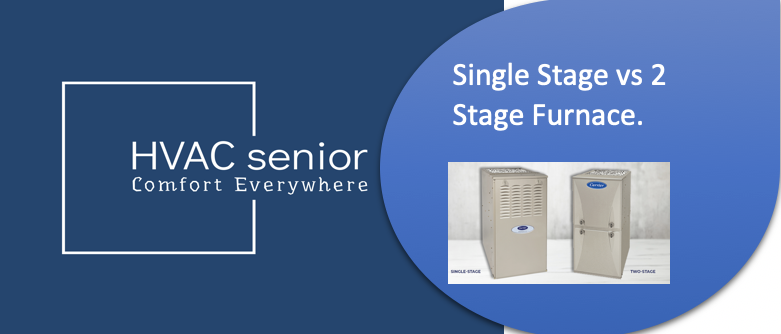Single Stage vs 2 Stage Furnace Explained.
In the ever-evolving landscape of home heating solutions, the decision for Single Stage vs 2 Stage Furnace is pivotal in shaping the comfort, efficiency, and overall energy consumption of your living space.
At a glance:
| A single-stage furnace. | Two-stage furnace. |
| One heating output setting. | Two heating output setting. |
| Operates at full capacity. | Can run at lower capacity during milder weather. |
| Low energy efficiency. | Improved energy efficiency. |
As we delve into this comprehensive guide, the intention is to empower you with the knowledge necessary to make an informed choice tailored to your specific needs and preferences.
Section 1: Understanding Single-Stage Furnaces.
A single-stage furnace is a traditional heating system designed to provide warmth to your home using a straightforward on/off mechanism. In essence, it functions as a binary device, operating at full capacity when activated and completely shutting off when the desired temperature is reached. To grasp the mechanics of a single-stage furnace, let’s break down its operation into key components.
Core Components.
–Thermostat Activation
The heating process begins with the activation of the thermostat, triggered by a drop in the indoor temperature below the preset level. This initiates a signal to the furnace, prompting it to start the heating cycle.
–Combustion and Heat Generation
Upon receiving the signal, the furnace ignites its burner to generate heat. In the case of a single-stage furnace, this process involves an all-or-nothing approach. The burner operates at its maximum capacity, producing a significant amount of heat intended to raise the temperature of the air circulating through the system.
–Blower Activation
Simultaneously, the blower fan is activated to distribute the heated air throughout the ductwork and into the living spaces. This process continues until the thermostat detects that the desired temperature has been achieved.
–On/Off Operation
Here lies the defining characteristic of a single-stage furnace. Once the desired temperature is reached, the furnace abruptly shuts off. There is no modulation of heat output or adjustment based on the actual heating needs of the moment. It’s a simple binary operation, akin to flipping a switch.
Advantages of Single-Stage Furnaces.
- Cost-Effective: The simplicity of the on/off mechanism contributes to lower upfront costs, making single-stage furnaces an appealing option for those with budget constraints.
- Reliability: With fewer components involved in the heating process, single-stage furnaces are often perceived as more robust and less prone to mechanical issues.
Disadvantages of Single-Stage Furnaces.
- Energy Inefficiency: Operating at full capacity regardless of the actual heating demands can lead to energy inefficiency, especially during milder weather conditions.
- Temperature Fluctuations: The abrupt on/off operation may result in temperature fluctuations within your home, as the furnace lacks the ability to modulate its output based on nuanced temperature requirements.
Understanding the inner workings of a single-stage furnace is crucial when contemplating your heating options.
While it offers simplicity and reliability, considerations of energy efficiency and temperature control should guide your decision-making process, especially when compared to the more nuanced operation of two-stage furnaces, as we’ll explore in the subsequent sections.
Section 2: Understanding Two-Stage Furnaces.
A two-stage furnace represents a sophisticated leap forward in heating technology, offering a nuanced approach to home comfort and energy efficiency. Unlike its single-stage counterpart, a two-stage furnace operates with the capability of adjusting its heat output to two distinct levels, providing a more tailored response to varying heating demands.
Core Components and Operation.
–Thermostat Activation
Similar to a single-stage furnace, the heating process begins with the activation of the thermostat in response to a drop in indoor temperature. This triggers the furnace to initiate the heating cycle.
–First Stage: Low Heat Output
During milder weather conditions or when the initial heating demand is detected, the two-stage furnace engages its first stage. In this phase, the furnace operates at a lower capacity, producing a moderate amount of heat to meet the current needs without unnecessarily expending excessive energy.
–Second Stage: High Heat Output
As the temperature continues to drop or when the demand for heat increases, the furnace transitions to its second stage. In this stage, the furnace operates at full capacity, providing a higher volume of heat to quickly and efficiently warm your home.
–Modulation for Efficiency
The ability to modulate between these two heat output levels is where the efficiency gains of a two-stage furnace become apparent. By matching the heating output more closely to the actual requirements, the furnace minimizes energy consumption during periods of less extreme weather, leading to potential cost savings on utility bills.
–Improved Temperature Control
Beyond efficiency, the modulation between stages contributes to enhanced temperature control. The gradual adjustment in heat output helps prevent sudden temperature spikes and provides a more consistent and comfortable indoor environment.
Advantages of Two-Stage Furnaces.
- Increased Energy Efficiency: The modulation capability allows the furnace to operate at a lower capacity when full power is not required, resulting in improved energy efficiency and potential long-term cost savings.
- Enhanced Temperature Control: The two-stage operation provides a more gradual and precise response to temperature fluctuations, reducing the likelihood of abrupt changes in indoor comfort.
Disadvantages of Two-Stage Furnaces.
–Maintenance Complexity
The dual-stage operation introduces a level of complexity that may require more intricate maintenance and repairs. HVAC professionals may need specialized training to address issues specific to two-stage furnaces, potentially leading to higher service costs.
–Compatibility with Existing Systems
Retrofitting a two-stage furnace into an existing heating system may pose challenges, especially if the ductwork or other components are not optimized for the nuanced operation of a two-stage system. This could lead to additional expenses for system modifications.
–Overestimation of Efficiency Gains
Homeowners may overestimate the potential energy savings associated with two-stage furnaces. While these systems offer increased efficiency during milder weather conditions, the actual savings depend on various factors, including the climate, insulation, and overall home efficiency.
–Limited Performance Advantage in Some Climates
In regions with consistently cold temperatures, the benefits of two-stage furnaces may not be as pronounced. The system’s ability to modulate heat output efficiently during mild weather may not be fully utilized, potentially diminishing the perceived advantages.
–Cost Considerations
When evaluating furnace options for your home, cost considerations are paramount. In this section, we’ll delve into both the upfront costs and the ongoing operating costs associated with single-stage and two-stage furnaces.
- Upfront Costs:
Single-Stage Furnaces:
Lower Initial Investment: One of the key advantages of single-stage furnaces is their simplicity, translating to a lower upfront cost. For homeowners on a budget, this can be an appealing factor, especially when considering the immediate financial outlay.
Two-Stage Furnaces:
Higher Initial Investment: The increased capabilities and efficiency of two-stage furnaces come at a cost. These systems typically involve a higher upfront investment compared to their single-stage counterparts. However, it’s important to view this expense as a long-term investment in energy efficiency and enhanced comfort.
- Operating Costs:
Single-Stage Furnaces:
Energy Consumption: The straightforward on/off mechanism of single-stage furnaces can lead to less energy-efficient operation, especially during periods of mild weather when the furnace operates at full capacity. This may result in higher monthly heating bills, as energy consumption remains consistently high.
Two-Stage Furnaces:
Energy Efficiency: The ability of two-stage furnaces to modulate their heat output based on current heating demands contributes to improved energy efficiency. During milder weather, the furnace operates at a lower capacity, potentially leading to lower monthly heating bills compared to single-stage furnaces.
Considerations for Decision-Making:
Short-Term vs. Long-Term: While single-stage furnaces may provide a cost advantage in the short term, it’s crucial to consider the long-term savings offered by the increased energy efficiency of two-stage furnaces. Assess your budgetary constraints and long-term financial goals.
Energy Savings: Factor in the potential monthly energy savings associated with a two-stage furnace. Though the upfront investment may be higher, the efficiency gains can lead to a more cost-effective heating solution over the life of the furnace.
Return on Investment: Evaluate the return on investment (ROI) by weighing the upfront costs against the expected savings in monthly operating costs over time. This holistic approach provides a comprehensive perspective on the financial implications of your furnace choice.
Also read>>>Furnace Turns On But No Heat.
Frequently Asked Questions (FAQs)
What are the main differences in operation between a single-stage and a two-stage furnace?
A single-stage furnace operates on a simple on/off mechanism, running at full capacity until the desired temperature is reached, then shutting off completely. In contrast, a two-stage furnace modulates its heat output with two distinct levels, allowing for more efficient operation by adjusting to varying heating demands.
How do the upfront costs compare between single-stage and two-stage furnaces?
Single-stage furnaces generally have a lower initial investment due to their simpler design. Two-stage furnaces, offering enhanced features and efficiency, come with a higher upfront cost. Homeowners should consider their budget constraints and long-term cost-effectiveness when making a decision.
Are two-stage furnaces more energy-efficient, and how does that affect monthly heating bills?
Yes, two-stage furnaces are generally more energy-efficient due to their ability to modulate heat output. This efficiency can lead to potential monthly savings, especially during milder weather conditions when the furnace operates at a lower capacity. While the upfront cost may be higher, the long-term savings in operating costs should be considered.
What are the potential drawbacks of opting for a two-stage furnace?
Some disadvantages include higher upfront costs, potential maintenance complexity, and the need for compatibility with existing systems. Additionally, in regions with consistently cold temperatures, the advantages of a two-stage furnace may not be as pronounced. Homeowners should carefully assess these factors against the perceived benefits before making a decision.
Conclusion.
Choosing Single Stage vs 2 Stage Furnace demands a nuanced understanding of their operations, advantages, and drawbacks. While single-stage furnaces offer simplicity and lower upfront costs, two-stage counterparts provide enhanced efficiency and temperature control. Consider your budget, climate, and long-term goals to make an informed decision aligning with your unique needs.

